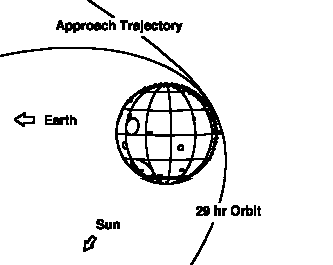 | |||||
|
 | |||||
|
Mars Climate Orbiter - Mars Orbit Insertion
Mars Orbit Insertion Quick Facts Mars Arrival Date: September 23, 1999 Speed before engine firing (relative to Mars): 12,300 mph (5.5 km/sec)
Speed after engine fireing (relative to Mars): 9,840 mph (4.4 km/sec)
Change in speed from engine firing: 3,065 mph (1.37 km/sec)Earth-Mars distance at arrival: 121.9 million miles (196.2 million km) One-way speed-of-light time from Mars To Earth: 10 minutes, 49 seconds Mars season at arrival: Fall in northern hemisphere, spring in southern hemisphere

Mars Climate Orbiter Engine BurnThe Mars Climate Orbiter will arrive at Mars on September 23, 1999. As it nears its closest point to the planet coming in over the northern hemisphere, the spacecraft will fire its 640-newton main engine for 16 minutes 23 seconds to brake into an elliptical capture orbit. The spacecraft will loop around Mars roughly once every 12 to 17 hours. The period of the capture orbit will increase if launch takes place on a later date, due to an increasing arrival velocity. If launch takes place at the end of the launch period in late December, the capture orbit period would be approximately 20 hours.
Mars Climate Orbiter MOI Timeline
September 23, 1999
All times in Earth Receive Time (ERT).
One way light time from Mars is 10 minutes 49 seconds.Event PDT EDT UTC Orbiter stows solar array 01:41 04:41 08:41 Orbiter turns to correct orientation
to begin main engine burn01:50 04:50 08:50 Orbiter fires pyrotechnic devices
which open valves to begin
pressurizing the fuel and oxidizer tanks01:56 04:56 08:56 Main engine burn starts,
fires for 16 minutes 23 seconds.02:01 05:01 09:01 Orbiter passes behind Mars,
out of view from Earth02:06 05:06 09:06 Main engine burn ends 02:17 05:17 09:17 Orbiter turns to orientation which will
allow Earth contact02:19 05:19 09:19 Orbiter comes out from behind Mars,
flight controllers regain contact02:27 05:27 09:27 Solar array unstows 02:30 05:30 09:30
After completion of the burn, the spacecraft will be turned to point its high-gain antenna at Earth. During the first two days after orbit insertion, the spacecraft will communicate continuously with the Deep Space Network's 70-meter (230-foot) and 34-meter (112-foot) antennas.


Mars Climate Orbiter Approach TrajectoryBased on the details of the initial capture orbit, the spacecraft will fire its thrusters during its next closest pass by Mars to lower the orbit and reduce the orbit period by two to four hours. The flight team will work to achieve as low an orbit as possible to reduce the amount of time required for aerobraking.
MARS ORBIT INSERTION (MOI) STRATEGY
Northern Approach
- Initial inclination targeted 0.1 degree high to accommodate inclination perturbations during aerobraking.
- Aimpoint chosen to keep periapse altitude > 150 km during Mars orbit insertion (heating constraint).
MOI-1: biprop burn
- Burn Oxidizer to depletion (16 minute burn)
- Main engine cutoff at accelerometer reading
of 65% - 75% thrust, with timer backup.
(Biprop system is isolated prior to cutoff)
- Imparted ÆV depends on approach mass, and
performance of biprop system
MOI-2: Hydrazine makeup burn:
- Supplemental Hydrazine burn follows 60 seconds
later, as needed, to yield desired orbit period.- For launch at end of primary, makeup burn
is required 88% of the time.- Allows earlier walk-in maneuver than a next-rev burn
- Cutoff determined by accelerometer detection of total ÆV required, with timer backup.
Target is 29 hr maximum orbit period for launch at end of Primary
- 99% probability of aerobraking completion by Lander arrival
- Orbit period ~ 26 hrs at start of Primary, ~ 36 hrs at end of Secondary
Aerobraking
| Home | Mars Climate Orbiter | Mars Polar Lander | Deep Space 2 Microprobes |
| Welcome | Mailing List | Links | Credits |
For questions or comments on this website please refer to our list of contacts.